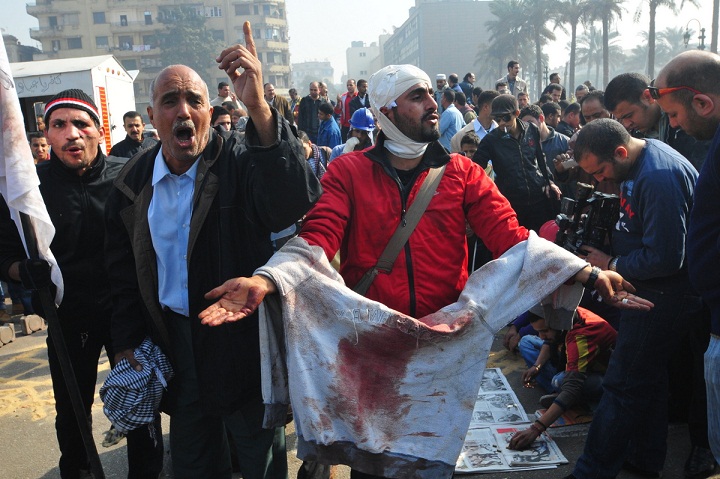The run up to the clashes
The year 2011 started with a revolution in January, and ended with deadly clashes in December. In between, the country lived through some of its most turbulent times.
When former President Hosni Mubarak was ousted in February 2011, power was handed over to the Supreme Council of Armed Forces. Under military rule, thousands were arrested and tried in military courts, while violent stand-offs between security forces and protesters were repeated almost on a daily basis.
The clashes between security forces and protesters that took place at the Cabinet Office headquarters on 16 December, 2011, were not an isolated incident. Soon to be known as the Cabinet Office clashes, it would result in four months of violence.
Clashes started outside the Israeli Embassy in September, then in October outside Maspero (which hosts state-run television) and in Mohamed Mahmoud Street in November.
After protesters were violently dispersed in the Mohamed Mahmoud street clashes, amid a death toll in the dozens and with hundreds others injured, a group of protesters decided to start a sit-in by the Cabinet building, located in Al-Qasr Al-Aini Street, just off Tahrir Square.
Protesters chose to hold their sit-in by the Cabinet Office in opposition to the appointment of Prime Minister Kamal Al-Ghanzoury in place of Essam Sharaf. Al-Ganzoury was appointed days after Sharaf resigned, in the midst of the Mohamed Mahmoud clashes.
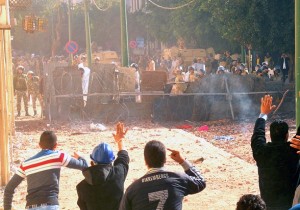
The Cabinet clashes
For weeks, the sit-in was peaceful, except for the death of one protestor, Ahmed Sorour, who was hit by a Central Security Forces’ vehicle. Police claimed his death was an accident.
The clashes on 16 December started when one of the protesters, Aboudy Ibrahim, was apprehended for almost an hour and severely beaten by security forces.
Ahmed Doma, famous revolutionary activist and poet, said he was one of the organisers of the sit-in. He added that he was not present in the cabinet area before the incident started. At the time, he was buying food and other items for the protesters when he received a phone call saying that military forces had kidnapped Ibrahim.
“The military knows Aboudy very well, as he had always led protests against their rule,” Doma said.
According to Doma, protesters caught a military investigation officer who had infiltrated the sit-in, trying to get information about the protesters and their activities. He added that the officer was caught a few minutes before Ibrahim was kidnapped.
The revolutionary poet claimed that military personnel tried to convince protesters to exchange Ibrahim for the captured military officer. However, the protesters refused.
“A few minutes later, a body was thrown out of the People’s Assembly gate. We checked the body to find out that it was Aboudy, who was beaten until blood covered his whole body,” Doma said.
A video of Ibrahim shows his face bruised, swollen and bleeding from the beating.
Earlier Ibrahim had approached an army officer, asking for his ID, explaining that he had heard security forces in the area were kidnapping people. The officer made a phone call and security forces showed up shortly afterwards from inside the People’s Assembly, close to the Cabinet Office headquarters.
“Yes, it is I, who has been kidnapping people,” the officer said, before beating Ibrahim on the head with the back of his gun. Ibrahim was then apprehended and beaten further.
Doma stated that the protesters were furious after seeing what happened to Ibrahim and they started to insult military officers, before the situation turned bloody.
“Military officers located on the top of the Cabinet Office and People’s Assembly buildings started to throw rocks and marble bricks on us, resulting in many injuries and deaths among the protesters,” Doma said.
PM Al-Ganzoury, however, claimed the clashes started for a different reason. His Cabinet released a statement explaining that the protesters were playing football when the ball ended up inside the Cabinet Office building. “One of the protestors tried to retrieve it from inside, but it seems he was badly treated,” the statement read.
The armed forces statement in response to the clashes declared, “[Do we not] have the right to defend the property of the Egyptian people, which we swore we would defend?”
Al-Ganzoury condemned the protesters for throwing stones at the Cabinet Offices. He resorted to the same vague claims used in response to the Maspero and Mohamed Mahmoud clashes; groups who do not want the best for the country were somehow involved.
The ensuing clashes between the army and protesters after Ibrahim was released, left at least 17 people dead and hundreds more injured. The clashes started in the early hours of Friday 16 December and continued for several days.
Testimonies of brutality
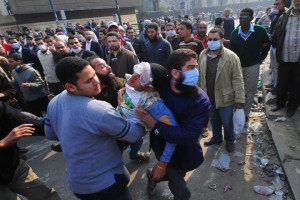
Doma claimed, during the clashes, officers sprayed protesters with teargas and burnt protesters’ tents. He added, “this violent attack led us to withdraw to Al-Qasr Al-Aini Street, where we left the field hospital behind us.”
According to Doma, protesters tried to notify military officers not to attack the hospital. Instead of retreating, officers directed the teargas towards the area of the hospital; aware of the presence of injured protesters inside.
Mostafa Abdel Dayem, a protester who received a gunshot wound in his spinal cord, said he was shot by a military officer while he tried to protect other injured protesters on 16 December. Abdel Dayem said he was transferred to Al-Helal hospital and then to Al-Qasr Al-Aini hospital, adding that both hospitals couldn’t treat his case.
Abdel Dayem is now undergoing treatment at the New Teaching Al-Qasr Al-Aini hospital, suffering from paralysis.
Mohamed El-Menyawy, another protester, was injured in the head after being hit with a marble brick on the night of 17 December. “I was knocked out after being hit and woke to find myself in the field hospital. There were no tools available to treat me there, so I was transferred to Al-Qasr Al-Aini hospital,” he said.
El-Menyawy asserted that he was treated inhumanely by the Al-Qasr Al-Aini administration, who left him bleeding for two hours before a doctor came to see him. “I had 13 stitches in my head, and I paid for my treatment.”
“We don’t want money, we only want to be treated as humans,” stated El-Menyawy.
Fahd Ibrahim, student of architecture and revolutionary activist, said military forces wearing black t-shirts threw rocks and large marble bricks from the top of the Cabinet Office and People’s Assembly buildings.
He added that protesters did not have Molotov cocktails to begin with, explaining they created them during the clashes in retaliation to the violent attacks by military personnel. “Protesters hid behind a wall and prepared a Molotov cocktail, while we tried to throw rocks at the military officers. Nothing reached them because they were standing on top of the tall buildings.”
Ibrahim said military officers on the Cabinet Office ground floor fired birdshots and live ammunition at protesters. He added that his leg was broken when a large marble brick fell on him.
“At that same moment, another protester was shot behind me and we were both carried to the field hospital. I left the hospital limping, while he left it in his shroud,” he said.
On 20 December, the armed forces released another statement calling for calm in order to identify the hired “thugs” behind the destruction and vandalism. The next day, the military released yet another statement asserting the right of the Egyptian people to peaceful protest without causing harm to public or private institutions. The army warned of a conspiracy against the country and called on protesters to be cautious and make sure that those “elements who are not trusted” do not infiltrate protests.
The girl in the blue bra
If Egypt remembers mid-December 2011 as the “Cabinet clashes,” internationally it’s often recalled as “the blue-bra incident,” The shocking photo which made it to international, before national, front pages warned that the Egyptian revolution could be taking a drastically different turn.
The anonymous, veiled girl whose abaya was ripped open as soldiers dragged her out of the square was perhaps the most scandalous attack on a woman seen during the Cabinet clashes, but it was by far not the only one.
Political activist Hend Nafe’ was also beaten and had her veil and clothes ripped off by a gang of over 20 soldiers, she stated in a video filmed while she was recovering in hospital. She claimed to have been, along with nine other women, dragged to a room within the Shura Council building, where they were tortured by way of sexual assault, beating and electrocution. Nafe’ is now a founding member of an anti-torture campaign entitled “Nation without Torture.”
Another female victim was doctor and blogger, Farida Al-Hessy, who headed to the makeshift hospital in Al-Qasr Al-Aini street on 17 December, in order to help those injured during the previous day’s clashes. Caught up in a stampede where protesters were chased by army soldiers, Al-Hessy found herself on the ground, being viciously attacked by army batons. Human rights activist Nour Ayman Nour, who happened to be present during the fighting, tried to shield her from the soldiers’ beatings, only to be beaten up himself. Al-Hessy was then dragged by her hair into the Peoples’ Assembly building, where one soldier slapped, cursed and threatened her with sexual assault.
Perhaps what was most shocking, however, was the reaction of some public figures’ to the attacks. Islamist preacher Khaled Abdallah’s prominence spiked as he sarcastically made fun of Mohamed ElBaradie’s criticism of the armed forces’ attack on “the girl in the blue bra,” cynically referring to him as “the believer”. While political pundit Tawfiq Okasha, declared that the girl got what she deserved for wearing such an obscene outfit without an undershirt. “Who would wear an abaya, commando, in this freezing cold unless she’s hot with liquor?” delivered Okasha without flinching. In fact, a large number of people at the time believed that the whole “blue bra incident” was a set-up, whereby revolutionaries wearing army outfits staged an assault on a female fellow-revolutionary in order to taint the armed forces.
Regardless, Egypt’s women didn’t cease taking to the square during the protests. Women’s marches, most notably one which started from Tahrir Square on 20 December, in the streets of downtown, where women chanted not only for their freedom, but also for their dignity.
Following the claims of abuse on female protesters, the armed forces released a statement saying, “the armed forces express their deepest regrets to the women of Egypt for the violations that happened….” The military claimed that all legal procedures had been taken to punish the violators.
Fire at the Scientific Compound
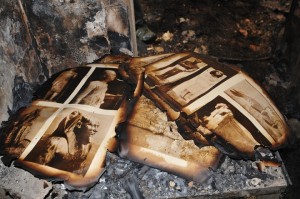
On 17 December, the Scientific Compound, a building over 200 years old, containing thousands of rare books and documents, was set alight. The fire destroyed almost everything. The building, which lies on Al-Qasr Al-Ainy Street, contained around 200,000 books including very rare documents, with some dating back to the 1700s. It cost of millions of Egyptian pounds to be renovated and re-opened in October 2012 with a collection of around 25,000 books.
Among those accused of burning it down were a number of minors. Adel Omara, former Deputy Defence Minister and member of the Supreme Council of the Armed Forces (SCAF), appeared in a press conference on 19 December where videos were shown of minors confessing to receiving money in order to spread violence and burn the compound.
Among those accused of funding the minors were Mohamed Hashem, owner of Merit Publishing house, and 6 April member Sherif Al-Rouby. News reports later showed that some of the minors were arrested before the Cabinet clashes took place; they were in custody at the time. Others later confessed to having been forced by the authorities to give false testimonies about their involvement in the clashes.
Human rights organizations condemned the shooting and broadcasting of such videos, calling it a grave violation of children’s rights by the SCAF. Article 116 of child’s law (126, year 2008) punishes anybody who distributes or broadcasts any information, data, drawings or pictures revealing the identity of a child subjected to danger or breaching laws.
The Muslim Brotherhood
After a day of silence and absence from the clashes’ zone, the Muslim Brotherhood released their first statement on 16 December, midnight. In the statement, the Brotherhood expressed their “shock” with the murder of civilians at the hands of the armed forces. They also suggested that chaos arrives whenever the state is moving towards development, adding that such action is usually an attempt to stall democratic transition of power.
The Brotherhood demanded the continuation of parliamentary elections as well as demanding presidential elections to be held in June 2012 as planned.
The statement was followed with another on 17 December, directly attacking Egyptian media outlets. The Brotherhood claimed that some outlets were going against the peoples’ wishes and attempting to tarnish the electoral process. They added that the same media outlets used to endorse the elections which took place during former President Hosni Mubarak’s era.
As to the Brotherhood’s political wing, the Freedom and Justice Party (FJP), the statement released on 16 December didn’t stray too far from the points the Brotherhood addressed. Besides denouncing the clashes, the FJP stated that the clashes were an attempt to distract the public from the parliamentary elections. It also warned, in a statement released on 20 December, of “treacherous powers inside and outside of Egypt,” which it accused of trying to dissolve the revolution.
Conversely, the party announced its rejection of what some political powers had proposed to resolve the clashes between the army and the revolutionaries. The proposition suggested holding the presidential elections before the first anniversary of the revolution on 25 January. At that time, the Brotherhood and its party had not yet announced their intention to run in the presidential elections.
Through it all, neither the Brotherhood nor the party members joined the protesters who contributed to the clashes or the marches which closely followed. Several political and revolutionary powers thus accused the Brotherhood of caring only about their personal interests, embodied in the parliamentary elections, and having little concern for the interests of the revolution.
The aftermath
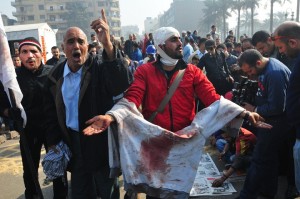
On Friday 23 December, a “million man” protest was held in Tahrir Square. In addition, marches were organised and symbolic funerals were held for martyrs. However, what the Cabinet clashes added to the revolutionary scene was a new strategy of protests. Before then, whenever people wished to voice displeasure with the authorities, they would all meet en masse in Tahrir Square. During the Cabinet clashes, however, very few protesters remained in the square. Instead, marches to Tahrir Square were held almost daily, coming from different directions. This acted as a prelude to a new form of protest which was enacted starting 25 January 2012. Protest marches gained momentum as more people would join in every street.
The parliamentary elections resumed after the clashes, and the People’s Assembly held its first session on 23 January, just days ahead of the anniversary of the 2011 Revolution.
Clashes resumed in Mohamed Mahmoud Street in February 2012, following what came to be known as the Port Said massacre which left over 70 football fans dead.
The beginning of 2012 also saw the widening of a rift between Tahrir Square frequenters and the Muslim Brotherhood, who won the largest share of seats of the People’s Assembly.
Despite power being finally handed over to President Mohamed Morsy’s civilian rule in June 2012, it has become clear towards the end of 2012 that the abuses and violations which freedom fighters face in Egypt, are far from over.
